Type: Opinion
Sky announcement marks another blow to UK children’s content creation
The decision by Sky to end commissioning of original children’s content represents a significant loss to the UK’s animation and children’s media sector.
Under Lucy Murphy’s inspired leadership, Sky Kids has been a valued commissioner and supporter of original UK content, contributing to the strength of the UK’s world-class children’s production sector. The decision will come as a significant blow to the many animation creators, studios, and freelancers who have helped build Sky’s acclaimed slate.
While Animation UK welcomes Sky’s assurance that it will continue to honour existing commissions and maintain a schedule of children’s content, the shift away from original UK content towards acquired programming adds to an escalating crisis in children’s television.
This news arrives at a time of growing concern across the industry, with public service broadcasters also under pressure and independent producers struggling to find sustainable pathways for financing and distribution. The loss of a major commissioner, such as Sky, reduces creative opportunities and limits the ability of UK producers to reach audiences with culturally relevant stories and characters.
This development underscores the importance of the newly launched Culture, Media and Sport Committee inquiry into Children’s TV and Video Content. We will be submitting evidence to highlight the structural challenges facing the sector and the urgent need for targeted policy interventions to support UK children’s content production.
Sky has played a valuable role in backing original UK animation and children’s programming. Its decision to step away from commissioning is another signal that the children’s content sector needs urgent attention. Without intervention, we risk losing the UK’s ability to tell its own stories to its youngest citizens and to support our world class content creation sector.
Kate O’Connor, Executive Chair of Animation UK
Animation UK stands ready to work with government, regulators, and industry partners to ensure that future generations continue to enjoy high-quality, UK-made children’s programming that reflects their lives, values, and culture and to secure support for our world class animation sector.
Animation UK: MPs’ warning on British Film and TV echoes urgent concerns for animation sector
Animation UK welcomes the Culture, Media and Sport Select Committee’s powerful report on the urgent challenges facing the UK’s independent film and high-end TV sector. But we urge MPs to go further: the issues raised in this report are even more pronounced in the animation sector, a vibrant and growing part of the screen industries that is too often overlooked.
As the report rightly highlights, rising costs, market failure in public service commissioning, and an over-reliance on inward investment are threatening the creation of culturally British content. These same pressures are already having a chilling effect on the UK animation sector, which punches far above its weight economically, but remains vulnerable due to underinvestment and a lack of targeted support.
In our recently published Blueprint for Growth, Animation UK sets out a clear and cost-effective roadmap for addressing these challenges. Our five-point plan mirrors many of the Committee’s recommendations and shows how, with modest and strategic intervention, animation could double in size and contribution to UK GVA, growing from £1.7bn to over £2bn, and increasing employment to over 20,000 highly skilled jobs.
Key proposals include:
- A targeted uplift in tax relief for animation TV content, not just features, to match international competitiveness and stimulate growth.
- A revitalised focus on children’s content funding, reversing the decline in PSB investment, exploring contributions and quotas from streamers and ensuring young audiences can access high-quality UK content.
- Unlocking private investment and access to finance for animated IP, which has proven global value and export potential, by reviewing EIS and SEIS programmes and introducing new fiscal incentives. As well as support from the British Business Bank.
- Increased international co-production support via an increased UK Global Screen Fund and reaffiliation with Creative Europe.
- Investment in skills and education, recognising the sector’s digital potential and safeguarding the UK’s leadership in animation innovation, as well as craft and technical skills at all levels.
This is a pivotal moment. The Committee’s report makes clear what we’ve been saying: our world-class content industries face a systemic crisis. For animation, the warning lights have been flashing for some time. We fully endorse the Committee’s calls for stronger support but urge them to build on their recommendations by ensuring the distinctive needs of the UK animation sector are embedded into future evidence, analysis and policy.
Animation is one of the most geographically diverse and export-ready parts of the screen sector. With the right conditions, not handouts, but smart, targeted policies, it can thrive, drive growth, and tell British stories to the world. But without action, we risk losing that voice, that talent, and that future.
Kate O’Connor, Executive Chair of Animation UK
Animation UK stands ready to work with Parliament, Government, and industry partners to ensure these opportunities are not missed. We urge the CMS Committee to include evidence from animation as it takes this agenda forward.
Read the full British film and high-end television report by the Culture, Media and Sport Committee here.
Animation UK welcomes Government’s commitment to creative industries growth and regional investment
Animation UK welcomes today’s announcements from Culture Secretary Lisa Nandy at the Creative Industries Growth Summit in Gateshead.

Bottom (L-R): Wallace and Gromit: Vengeance Most Fowl by Aardman, and Kensuke’s Kingdom by Lupus Films.
The Government’s plans, including a £60 million package of support and new measures to enhance access to finance, mark a significant step forward in realising the potential of the creative industries as a driver of economic growth and global influence.
Animation, a cornerstone of the UK’s thriving film, TV, and wider creative sectors, is a standout contributor to the creative economy. It combines artistry, innovation, and technology to deliver cultural and economic value both domestically and globally. With recent data from the Animation UK Manifesto highlighting the sector’s £1.6 billion contribution to the UK economy, today’s announcements underscore the critical importance of sustained investment and strategic support as the sector has significant growth potential.
The Government’s overall recognition of the creative industries as a growth-driving sector within the Industrial Strategy is a welcome development, particularly the focus on key regions and nations, including the North East, West Yorkshire, Greater Manchester, and South Wales. Animation UK strongly supports this emphasis on regional growth, as the animation sector is inherently decentralised, with studios and talent hubs flourishing across the UK.
We are particularly encouraged by the continuation of the UK Global Screen Fund, a vital mechanism that enables British animation to reach international audiences, fostering export growth and co production funding. The announcement of enhanced support from the British Business Bank is another positive development. By increasing access to finance for creative businesses, including animation studios, the sector will be better equipped to scale, innovate, and realise its growth potential.
Today’s announcements are a clear signal of the Government’s commitment to unlocking the enormous potential of the UK’s creative industries. Animation is at the heart of this sector, driving innovation and creating globally loved content that enhances the UK’s soft power. The continuation of the UK Global Screen Fund, alongside regional investment and enhanced British Business Bank support, will enable animation studios to thrive across the UK, contributing to economic growth and cultural influence.
With its unique blend of creativity, technology, and storytelling, animation has the power to engage audiences worldwide and drive significant economic impact. We look forward to collaborating with the Sector Plan Task Force and the Government and industry partners to address key challenges, including skills development, access to finance, and innovation funding, and Kids content challenges to ensure the sector’s sustainable growth.
Kate O’Connor, Executive Chair and spokesperson for Animation UK
Speakers for Schools: Helping young people find their path into the creative industries
Laura Morris, Business Development Manager at Speakers for Schools, shares her thoughts on how to cultivate and nurture talent, and facilitate industry growth.

At Speakers for Schools, we aim to inspire young people and help them find their ideal career path within the UK’s many exciting sectors. Chief amongst those are the creative industries, and our free inspirational talks and work experience opportunities allow state school pupils to discover a career they might never have considered before or thought achievable.
With the creative industries generating £126 billion in gross value added to the economy and employing 2.4 million people in 2022 alone, we must introduce young people to the many opportunities within them as early as possible. Especially considering the range of different skillsets that can be accommodated and championed, whether you’re technical, creative or organisational.
It’s been a challenging few years for the industry, from COVID through to the writer/director/actor strikes. Meanwhile, The Sutton Trust’s new research, A Class Act, uncovered the stark disparities in access to creative careers and the extent to which they remain elite professions. For example, younger adults from working-class backgrounds are 4 times less likely to work in the creative industries compared to their middle-class peers. Meanwhile, BAFTA-nominated actors are 5 times more likely than the public to have attended private schools (35% vs 7%).
Now is the time to consider how we cultivate and nurture talent, and facilitate industry growth. As technology continues evolving, the demand for specialised skills will only grow, creating new career paths and opportunities for those willing to invest the time and effort to master them. It is encouraging therefore that the Chancellor of the Exchequer recently confirmed an increased tax incentive for spending on visual effects (“VFX”) in the UK, which has been warmly welcomed by the UK’s VFX industry. It is paramount that young people from all backgrounds are now given the right insight to understand how they can capitalise on such developments.
We are deeply invested in ensuring the creative industries are accessible to all and Discover! Creative Careers Week (18 – 22 November) represented a key moment to focus on the sector, providing the next generation with the tools to navigate it. Here, we partnered with Discover Creative Careers and ScreenSkills to offer work experience programmes across various creative fields from 28 October – 22 November. These allowed young people to gain real-world skills, build their portfolio, network with top creative minds and explore a variety of career pathways. Our data from last year’s programme for the same creative careers week reveals that 93% of young people were interested in a job within the sector after their work experience placement (compared to just 50% beforehand). This demonstrates the impact such early interventions can have in forming a young person’s passion and ambition.
Collaboration between all those working in this space – including the 190 companies in post production, VFX, animation, TV & Film Studios and Productive Services that UK Screen Alliance and Animation UK represent – is fundamental to ensuring the industry thrives and to addressing future skills gaps. For example, our partnership with film education charity Into Film showcased careers in the screen industries through virtual talks with industry experts; from actors, directors and producers to experts in post-production sound, picture editing and green filmmaking. We’ve similarly hosted many other in-person and virtual talks with aspirational role-models across the creative sectors, which are available to watch for free on our website.
The Government’s Autumn Budget allocated £3 million of funding to expand the Creative Careers Programme. Such initiatives are essential in providing insight into different career routes and tackling urgent skills gap in industries that are essential to the UK economy. We look forward to hearing more about the Government’s other key proposed policies that help young people find the right career for them; from recruiting more careers advisors in secondary schools to delivering two weeks’ worth of quality work experience for every young person (both of which are also central organisational missions of ours). Whether it be the creative sector or tech, we want to level the playing field for all young people and ensure everyone can enter the industry of their choosing.
We encourage employers working across the creative industries to get in touch and learn how they can get involved in our programme. Laura Morris and Melody Clarke are our Business Development Managers working across the sector, and you can contact them directly at laura.morris@speakersforschools.org / melody.clarke@speakersforschools.org.
For more information about Speakers for Schools, see their website here.
CEO of UK Screen Alliance looks ahead in 20th anniversary keynote speech
In a keynote speech, Neil Hatton, CEO of UK Screen Alliance, reflected on the organisation’s history and turned towards the future, laying out their response to the Government’s consultation on visual effects. The below speech was delivered at the UK Screen Alliance 20th anniversary gala dinner, held at Stationers’ Hall in London on 25 April 2024.

Good evening.
Not quite 20 years ago today, but close enough. The actual date was 4th March 2004, when we held our first open meeting for prospective members at BAFTA, for what was then known as UK Post.
I was part of the steering committee tasked with getting it going. And as the owner of a small insignificant editing boutique, I felt significant imposter syndrome when sitting alongside the likes of William Sargent, Alex Hope, David Jeffers, Nicky Sargent and our first chairman, the founder of MPC, the formidable Mike Luckwell.
Some of you here tonight, were present at that first event, like Nick Long from Salon, one of our longest standing members. Salon, the sponsors of tonight’s champagne reception, are also celebrating an anniversary this year; their 50th. So, join me in congratulating them.
We are also celebrating Animation UK. 14 years since they set up; 11 years of the Animation Tax credit, and 7 years since we came together to form the UK Screen Alliance, as we know it today. Please join me in thanking Kate O’Connor, who does sterling work on advocacy and promotion for the animation industry.
Thank you also to our board of directors, our councils and our working groups, both past and present, for their wisdom and insight.
And a big thanks to my team, Audrey and Ruxandra, who keep the wheels turning and have worked hard to bring tonight’s event together.
We really appreciate the kind words of the members who appeared on the video that you have just seen. A version with just the testimonials is now on our websites. We just could not do what we do, without the ongoing commitment our members. We just wouldn’t be able to operate at the level of intensity required to make a difference, without your moral and financial support. And we thank you for both.
For our awards tonight, big thanks go to our independent panel of judges who created the shortlists from your nominations and decided the overall winners.
I have already mentioned Salon, but sponsoring our awards are Tysers, Simons Muirhead Burton, Lucid Link and Percy and Warren. We couldn’t have put on this event without you.
And thank you all for supporting our anniversary event and allowing us to celebrate the outstanding achievement of tonight’s nominees and winners.
Much has changed over the last 20 years. Back in 2004, there were no photos taken of our first event – it was before phones had cameras; but they did have a decent battery life!
In 2004, the first ever series of Strictly Come Dancing was on the telly. If you saw it, you would have been watching in standard definition, as no UK broadcaster was transmitting HD at the time.
The kit to produce HD existed. At the NAB show in Las Vegas that year, pride of place on the Sony stand would have been HDCAM SR. The ultimate video recorder from the era of tape, eclipsed within a decade by file delivery.
In 2004, only half of UK households had internet access and the majority of those were still on dial-up. Remember the chirps and everyone moaning that you were blocking the phone line?
“The Facebook”, as it was called then, was barely 2 months old, and was a network for Harvard students only. Netflix was just a DVD rental business, slugging it out against Blockbuster. They certainly weren’t a global force in content making with Netflix Originals. Distributing films to consumers via dial-up internet just wasn’t a practical.
At that first meeting, we set out our aims. To represent the sector to Government, identify and tackle skills shortages, and market UK facilities on a global landscape. I remember saying, this must not be a job creation scheme for just one person, that of our yet to be appointed, first chief executive, Gaynor Davenport. It must be about creating thousands of jobs.
We supported the campaigns to re-introduce a film tax credit after the ending of sale and leaseback, and were involved in the TV Coalition to extend tax relief to High End TV. These were instrumental in the spectacular growth of the TV and Film industry. And now our own campaigns to get better tax relief for VFX and animation promise to create those many thousands of jobs, we hoped for at the outset.
We’ve grown in stature as an organisation. So often, digital production, post, VFX and animation, has been overshadowed by physical production, but we are now present at every high-level table, reminding the decision makers that we are just as important. That’s our role as your advocates; to be omnipresent, to make that presence felt, and create pressure for positive change.
My eight years at the helm of UK Screen Alliance have seen turbulent times for the UK and the world. We’ve been here to support you through Brexit, Covid, Strikes, an unprecedented boom and now sadly, a global production slowdown.
The last 12 months have been bittersweet. We know it is tough out there, and for many, the aim is to “survive to ’25”, but with the breakthroughs in the VFX and animation tax reliefs and the new indie film tax credit, there is new cause for optimism.
I want to highlight the role that DCMS and Lucy Frazer, the Culture Secretary, have played in bringing these initiatives into reality. She has been a big advocate for our sector, in lobbying for our case at Treasury. Our relationship with DCMS has never been better.
But there’s always something new for us to champion. The only constant is change, as it ever was, and we will be here to help you navigate it.
Our twenty years are a mere blink of the eye, compared to the history represented by this magnificent livery hall. I want to draw your attention to the stained glass window at the far end of the room. It depicts William Caxton demonstrating the printing press to Edward IV in the late 1470s. Caxton didn’t invent printing, that was Guttenberg, but he was the first person to introduce a printing press to England and the first English retailer of printed books, with titles like Canterbury Tales.
The Guttenberg printing press has been acknowledged as one of the most significant inventions of renaissance technology, democratizing access to knowledge and promoting literacy right across the known world (the Americas were yet to be discovered). The printing press led to modern day forms of communication such as novels, newspapers, and magazines; comic books, flyers, and billboards.
Five hundred years ago, if you made your living as a scribe, writing manuscripts by hand using a quill pen and ink, the printing press must have seemed, to use a modern phrase, disruptive technology, which threatened their occupation. While calligraphy still survives as a niche art form, printing spawned many new occupations, not just typesetters or booksellers, but creators of new forms of content, like novelists, journalists, or graphic artists. Does this scenario sound familiar? Can you see where I’m going with this?
We are experiencing the same kind of disruption now, from Generative AI, with the perceived threat to jobs. We can’t uninvent AI. We must learn to live with it and adapt. AI tools under the control of creative artists can make us more efficient and remove the drudgery of some roles, allowing more time to experiment with innovative ideas and to attempt new imagery that was just not possible before.
Disincentivizing the use of Generative AI in digital production, by excluding it from the VFX tax credit, as the Treasury have proposed in their current consultation, doesn’t make an sense to me. We would be the only country in the world to have an AI exclusion in their tax credit and that puts the UK at a disadvantage, potentially undoing some of the good that the new enhanced tax credit is meant to achieve. If we don’t embrace Gen AI in VFX, somebody else will. To have one hand tied behind our back, would cost artists’ and technologists’ jobs in the UK, creating new roles elsewhere rather then here, in the way we had hoped.
While the future path of AI is uncertain, such as how fast and how far it will become ubiquitous in our sector, we need to be at the heart of it, not on the sidelines. To quote Abraham Lincoln, “The best way to predict your future is to create it.” We will respond to the Treasury’s consultation and oppose the Generative AI exclusion from the VFX tax credit, backed up by convincing evidence and wide support from industry stakeholders. I’m hopeful that we can make that case.
I’m optimistic for the future of our sector, where human creativity will still be highly valued and central to the content that we output. Where AI opens new possibilities, but is firmly under the control of creative artists.
When UK Screen Alliance in partnership with Animation UK reaches our silver anniversary in five years time, I predict that we will still be celebrating outstanding achievement from creative and committed people, as we are tonight.
May I wish the best of luck to our award nominees later this evening. So now, let’s all eat, drink and be merry and look forward to a bright future.
Thank you.
The strike ends but the impact remains
Neil Hatton, CEO of UK Screen Alliance, reflects on the end of the 2023 SAG-AFTRA strike.
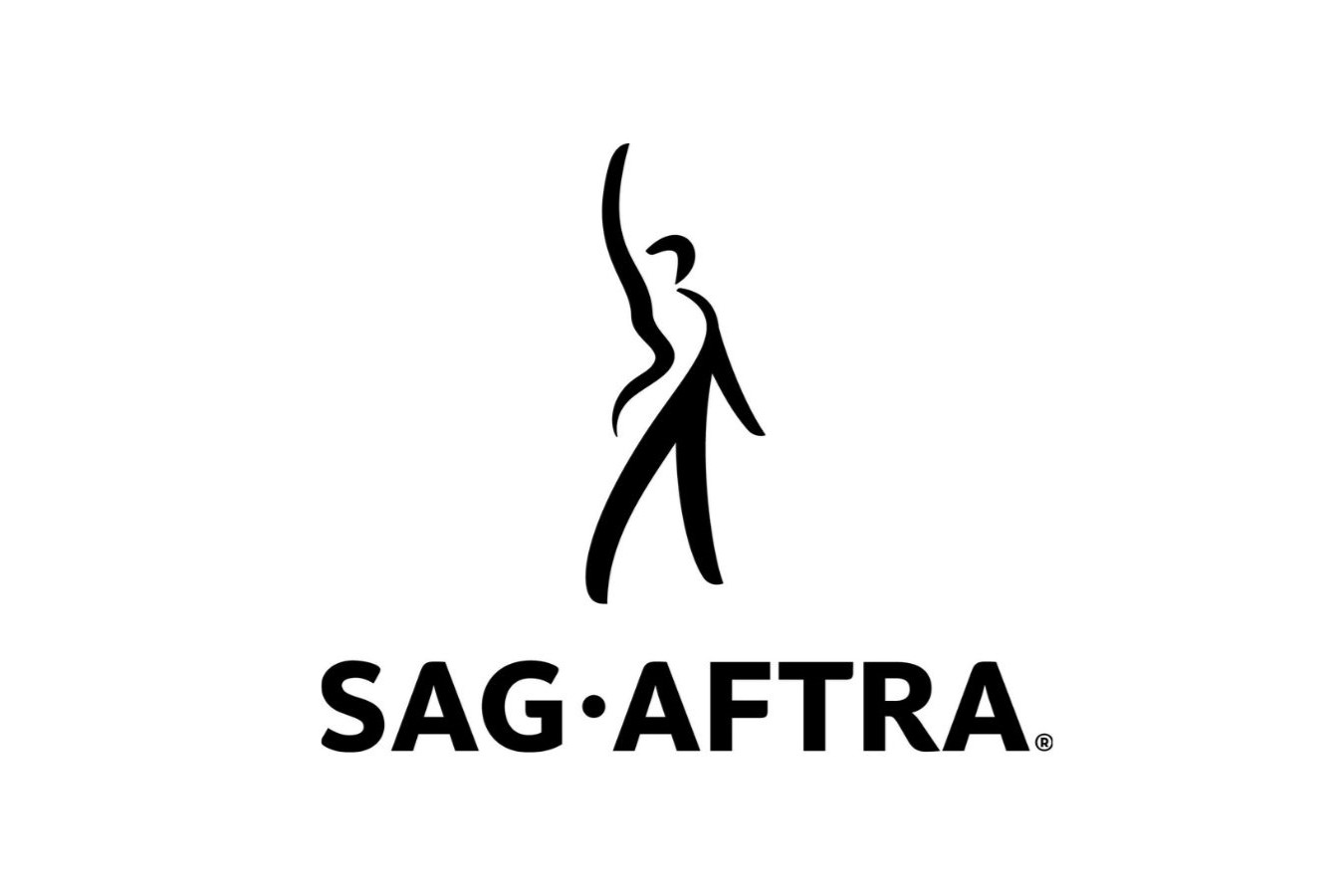
The end of the longest ever actor’s strike will undoubtedly bring some sense of relief for the film and TV industry across the world, including the UK, as many productions have been halted, postponed or cancelled since the industrial action began back in July. However for those in visual effects, there will still be an anxious time ahead, and for some it may get worse before it gets better.
It is expected that filming will resume in a matter of days or weeks on many productions, but it will be much longer before that material flows into VFX. UK Screen Alliance reports that its VFX members are not expecting anything like normal business levels to return until well into Q2 2024. There will be more layoffs as a result, and for some companies, it will be touch-and-go if they will survive.
While the actors can feel jubilant today, both they, the studios and the streamers should reflect on the collateral damage their dispute has caused for those in the rest of the production supply chain, who stood to gain nothing from the strike, but nonetheless felt all the pain.
For many VFX workers, this will have been the second long-term lay off since 2020. During the pandemic, UK Screen Alliance estimated that there were 23% job losses in VFX in the UK, and are expecting the figure to be nearer 40% for layoffs as a result of the strike. Some people will leave the industry, never to return, further exacerbating skills shortages once the rebound in work eventually comes.
The strike was just one issue in a more general production slowdown for all genres, so while there is now light at the end of the tunnel for scripted inward investment production, there are other problems depressing business levels in post production and animation in the UK which still persist. The lack of advertising revenue, leading to less commissioning by broadcasters in all genres; the market failure in children’s TV and lack of development funding; budget cuts that seem to have no end at the BBC; a distracted Channel 4; and an audience struggling with a cost of living crisis, to name but a few factors contributing to a perfect storm.
These are not easy times for our members in VFX, post production or animation, but today, it feels as if for some, a corner has been turned, although the path back to normality will be long and difficult.
Spotlight on…consultation, budget and vision: tax incentives for VFX and animation?
This month, Neil Hatton, CEO of UK Screen Alliance, highlights the Audio Visual Tax Reliefs consultation and delves into our recent proposal response on behalf of the industry.

Leaping to my feet from the audience, to announce, “Breaking news from Westminster!”, in the middle of the “State of the Nation” conference session at the Manchester Animation Festival last November, might have been a little dramatic, but I had received an email saying the Chancellor had just announced a consultation into the audio visual tax reliefs in his Autumn Statement. Apologies to Steve Henderson, the session chair that day for the interruption, but it was highly relevant to the topic being discussed. The consultation has rather dominated my months since, as it was immediately obvious that it offered an opportunity to pursue the goal which we have held for several years, for better VFX and animation tax relief. However, it became quickly evident that there were some parts of the consultation proposals which were unwelcome.
For more than a year now, we have been socialising our latest tax relief proposal around Westminster. The problem we are trying to address is that the 25% rate of tax relief available in the UK, whilst competitive for filming, doesn’t match up to the specific rebates for VFX and animation available in other countries, which range from 32% to 50%. We want to see the UK’s incentive for VFX and animation increase to be internationally competitive, and thereby boost the amount of projects choosing the UK for this work. Furthermore, our tax relief caps-out if you spend more than 80% of your budget in the UK. VFX, being the most portable part of the production, is very often removed from the UK as a result, and we know that over a three-year period, for films and TV series which qualified for UK tax relief by filming here, £1 billion of VFX was carried out abroad. These factors are stifling investment and growth in the UK.
For the first time, the Government acknowledged in the consultation proposals that the 80% cap disadvantages VFX in the UK. They offered to explore removing the cap, but this came with the significant negative caveat that it may necessitate a lower overall credit rate to avoid additional cost to the taxpayer. We are completely opposed to lowering the overall rate of relief, as that would seriously affect the filming incentive, and could lose the UK billions in inward investment and cost tens of thousands of jobs. It would be too high a price to pay for simply lifting the cap and wouldn’t help VFX either.
However, a proposal developed by UK Screen Alliance and Animation UK, with help from Saffrey Champness, offers an alternative, which does not cause extra net cost to the taxpayer, and means the rate does not need to decrease. By lifting the cap, only when more than 5% of the budget is spent in the UK on either animation or VFX, and then increasing the rate of relief for the VFX and animation elements only, our proposal will deliver more tax receipts from the increased economic activity, than the incentive will cost in the first place. It will be completely self-funding and will generate £260 million per year in value for the economy and more than 4,000 new jobs, spread across all four nations of the UK. We propose a net rate of tax relief of 32% for VFX and animation spend in London, and 37% for spend outside of London, putting the UK back on a level playing field with its competitor territories.
We’ve been taking every opportunity available to talk about our proposal with politicians from both Houses. I have spoken about it with two Secretaries of State at DCMS in the last six months, and to the Secretary of State for Business and Trade, as well as junior ministers and special advisors. I have been in meetings with Treasury officials and have spent a lot of time rallying support from industry stakeholders.
The Chancellor will deliver his Spring Budget on 15th March 2023, and we have made representations through official channels for our proposal, as well as, responding to the tax relief consultation. It is perhaps unlikely that we will hear any announcements in this Budget, as the Treasury aren’t expected to announce their conclusions on the consultation for a while yet, but you never know.
Last week, I listened to the new culture secretary, Lucy Frazer, speaking to the Creative Industries Council, a group of creative sector leaders to which I have now been appointed. She stated her priorities as Skills, Tax and Clusters, and stressed that both the PM and Chancellor recognise the potential of the Creative Industries. Soon, she will deliver the much-delayed Creative Sector Vision, so there are plenty of opportunities in the coming weeks and months for the Government to announce support for our plans for growth in VFX and animation, the most future-facing digital parts of the film and TV industry. At this stage I can’t predict how it will go but we are giving it a good shot, so let’s keep our fingers crossed for progress.
Spotlight on…The Look: How to make the post-production process easier
This month, Thomas Urbye, CEO of The Look, explores the challenges arising in post-production from the lack of clearly defined roles and suggests how to overcome these hurdles.

During the lockdown, the weekly UK Screen Alliance Zoom meetings – which discussed the impacts of the pandemic – showed that the sector now employed serious business minded and employee focused people, and I found these meetings very rewarding and reassuring. Recently though, I was chatting with a post-production supervisor who remarked that a couple of industry contacts, in various specialisms, have left the sector because it was “toxic”.
In the twenty years I’ve been working in film and television, I’ve rarely met anyone I thought of as toxic. Toxicity can manifest itself when people feel that they have to strongly defend their position due to a fear that their ego could be damaged; as such, they can be toxic to a team’s dynamic.
In my view, the challenges of a post-production vendor have mostly arisen from the lack of clearly defining the roles that each member of the post-production process will take ownership of, whether that is from us as vendors or the production company, broadcasters, VFX vendors or the post producers, post supervisors and VFX post producers employed on freelance contracts.

Courtesy of Netflix
The common theme we discuss internally, and with many of the teams at other post-production companies, is how do we mitigate challenges at the delivery stage on a project? Here, VFX shots are still outstanding from multiple vendors, and new ones are being pulled close to deadline. Broadcasters add ever more deliverables or changing them, directors make further trims to the edit and there is lots of information via email, phone and in-person. This is where a well-organised, clearly defined post-production team comes in to its own.
Modern High-End television series have gone from a few VFX shots per episode (mostly clean-ups), to huge 200+ VFX and 200+ Online shots per episode. As such, an eight part series essentially becomes eight mini feature films, with each episode having directors eager for their episode to have as much care and investment as the first. In these instances, clear roles and responsibilities are needed between the various stakeholders. However, due to the nature of the parties changing on every project, this becomes more challenging to introduce.
A practical example is the producing and supervising teams may be hands-off on one project, agreeing to work with a post or VFX vendor’s project management tools, but not being present for client reviews. On other occasions, teams will bring their own spreadsheets and ways of working, which may not align easily with the vendor. The former can leave vendors with unanswered questions and exposed to differing voices, including the ever increasing number of executive producers making direct work requests. With the latter, a vendor’s tried and tested, customised tools are made redundant and this can lead to more errors and out-of-date information when a project is moving at a very fast pace.
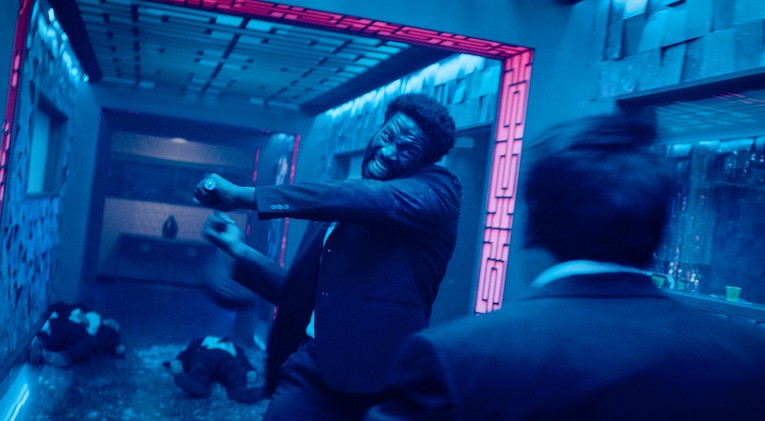
Courtesy of Sky
As production companies have looked to split off the responsibility of VFX shot management to VFX coordinators, this can lead to more confusion on who is arranging what – who books the VFX review time, who manages the director’s time throughout post-production, is it one person or many? When are directors shown versions and where? When the production companies have their own permanent heads of post-production – and broadcasters too – where does their role start and end, how macro or micro do these people need to be?
Often all the stakeholders learn the project dynamics as they progress through post; parties try to communicate, build rapport and understand where they can help cover bases. Unfortunately, if this conversation of roles and responsibilities is raised too early in the process, it can be seen as dictatorial. Likewise, when it comes up much later, perhaps when some things have fallen through the cracks, it can feel judgemental, as if the parties are pointing fingers.
The role of the post producer, or supervisor, is complex, as it involves managing expectations upwards, sideways and down. Director’s demands, combined with ever tightening deadlines means decisions are left to the last possible moment. If a vendor is genuinely not able to perform a task as quickly as the parties would like, it is important that there is an understanding rather than a confrontation. Rushing only leads to errors in delivery quality.

Courtesy of Netflix
The ideal, for any production company, would be that the freelance consultants and vendors they employ, only work on their project for months at a time. For vendors and consultants, the cost to the production company would increase the costs of the post-production by many multiples, so much so that it would be impossible to fund it. Even with other projects seamlessly laid out at the start of shooting, schedules always change. Vendors have to navigate how much work to take on to be able to do an excellent job, but also, be able pay their own people, turn a profit and stay in business. However, planning accurately in post-production is impossible; schedules and decisions are delayed – the only thing that is inevitable is change itself.
For any business and project to run smoothly then, we must create the environment for efficient team working. Each stakeholder needs to know what their job description and role involves, and it needs to be clear to those around them. For modern post-production to be able to tackle ever more complex projects, all of the parties will need to define the tasks that need to be done, starting with the job description set by the production companies to the freelance post producing teams, as well as the vendors. Ultimately, it is the production company and the series producer that the parties all answer too – as the phrase goes, the person with the gold makes the rules.
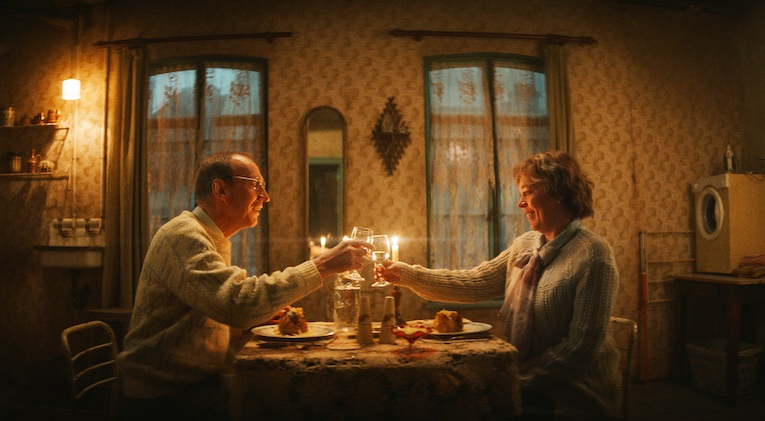
Courtesy of Sky/HBO
As each freelance team will differ in their way of working, as a vendor, we must mould our working to theirs, ensuring that all the tasks required are covered by someone in the process. At times, mistakes will be made, but this should not in turn be an opportunity to find fault in the people, but a chance to re-look at the process. The best collaborators are the ones who understand that those involved are all human. When this is achieved early on in any project, it will always run smoother and this applies to any industry.
So, if you find yourself thinking, “how did this project get so difficult?”, see if the above played a part and if clearly defining roles and responsibilities would have helped.
Finally then, a call to action for all involved. Ask the stakeholders to get around a table early on and work out all the aspects of a given project. From there, be ready to overcome the challenges together. Work as a united team with the same common goals to deliver the project to the best it can be, without toxicity, and with fun along the way.
VFX and Post Training: Where’s the money gone?
Neil Hatton, CEO of industry trade body UK Screen Alliance, highlights the lack of training funds flowing into post & VFX companies.
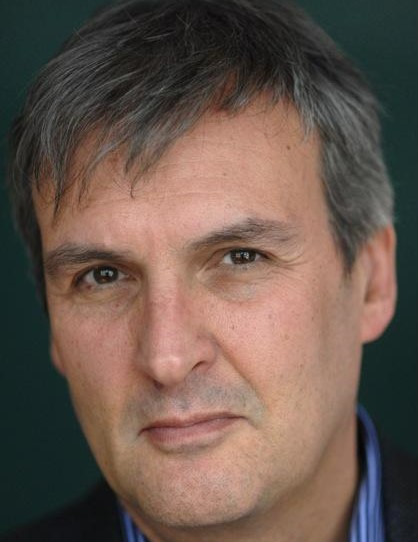
If you ask film or TV employers where the current skills shortages are, you always get the same genuine, but less-than-useful answer, “Everywhere!”. It’s identical whether you ask production, post production or VFX.
The current training subsidies from the industry’s voluntary skills funds are aimed, often exclusively, towards freelancers rather then employees. Post & VFX workers are overwhelmingly on PAYE contracts, so these essential parts of the creative production process are not being well served by the HETV, Film or Unscripted Skills Funds. This isn’t ScreenSkills fault; they just manage the funds. It’s the production companies making the voluntary contributions, who set the rules on how the cash can be used. They argue that freelancers are a special case, as it’s difficult for them to organise their own training; companies should pay for the development of their own employees and don’t need help from the funds. Yet all the time producers are looking for the most competitive deal on their post & VFX, leaving little margin for training.
I don’t deny that freelancers need extra help, but companies provide the best training ground for new entrants and many freelancers will have started as employees. Post and VFX companies are currently seeing unprecedented levels of poaching by streamers and production companies for post coordinators, post producers and edit assistants. All these highly-skilled people, have been developed within companies, and for the most part, without using training subsidies. It’s not a wise move for producers or streamers to cannibalise their supply chain in order to solve their own internal shortages, especially when they are not prepared to help backfill the skills gaps caused by their actions.
A recent report by Nordicity and Saffrey Champness for ScreenSkills, predicts growth in film & HETV production of 25% to 35% between 2021 and 2025, requiring an additional 15,310 to 20,770 new jobs. The report estimates this will need between £95.1m and £104.3m per year to train this expanded workforce; around 1.4% of the forecast level of production spending in film & HETV in 2025.
The BFI Skills Review echoes this prediction, and calls for a minimum of 1% of production budgets to be spent on skills and training and it warns if industry doesn’t meet this level of investment, legislation could make it compulsory. It’s a clear message from Government that there will be no new public money to sort this, but since we already have significant skills shortages, it will require a major shift in thinking.
Margins in post & VFX are under severe pressure despite the overall busyness of the sector. Wage inflation is significant because of tight labour supply, and the tripling of energy costs alone is enough to wipe out most companies’ training budgets. If the producers in charge of existing skills funds don’t want to help their suppliers, what are we to do to ensure a fairer distribution of training subsidies?
Every post & VFX house could put a line item on all their invoices for a “1% contribution to staff training”. However, to audit this and ensure that the revenue really does go to training, it would be better if this levy was paid directly by producers into a new industry fund which could coordinate targeted interventions for the benefit of the whole post & VFX sector. This would also avoid the siloed approach of the current genre-based skills funds.
So that producers don’t squeeze the rest of the budget to pay for a post & VFX skills levy, there should be an agreement to pass this cost, as a ring-fenced item, up-the-line to their commissioners and funders, just as they do with their own contributions to the HETV Skills Fund.
Our VFX artists, colourists and dubbing mixers are recognised as world-class and there’s a huge growth opportunity for post & VFX companies, but without continuing to develop our workforce that will quickly turn to decline. Through a new Post & VFX Skills Fund, we can ensure that post & VFX companies get their fair share of that proposed £104.3m per year investment in skills, and redress the balance of training funds for employees as well as freelancers.
This article was first published by Televisual on 14th July 2022.
Animation UK at The Children’s Media Conference 2022
While the momentous political upheavals were a constant backdrop, this further emphasised The Children’s Media Conference debate about the important issues facing the kids content and audience. As sponsor, Animation UK produced sessions, actively contributed to the debates and on behalf of our members.
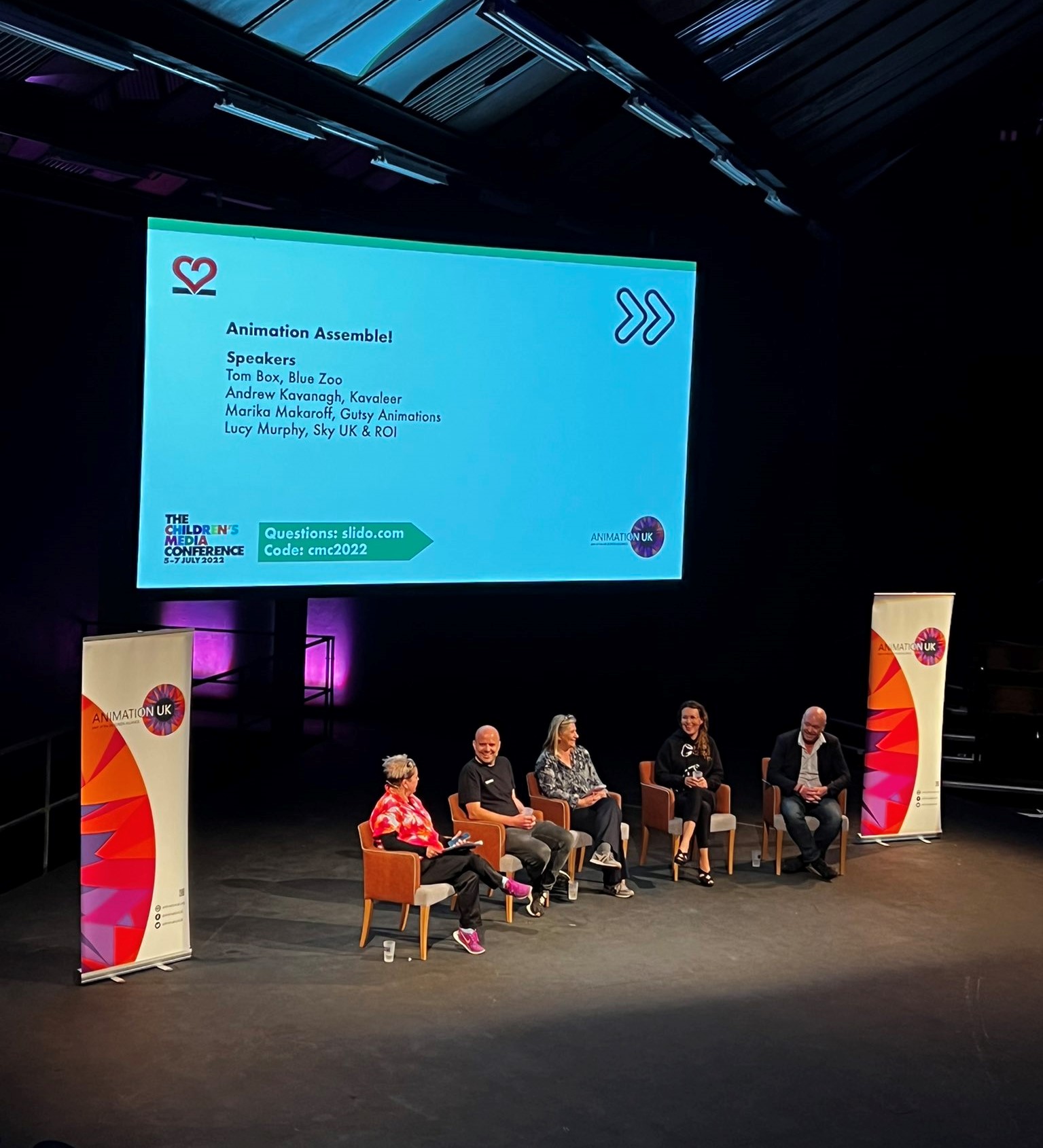
We were very proud to sponsor the Animation Assemble! session, which looked at animation as a force for good, both on and off screen. In addition to an excellent discussion at Question Time, a session looking at the future after the Young Audiences Content Fund discussed options presented by Jon Gisby and a statement by John McVay from PACT. On behalf of Animation UK, Oli Hyatt of Blue Zoo (Founder of Animation UK) presented a bold plan calling for a new and enhanced fund, based on the needs of the audience, embracing PSM values and commercial opportunities. With a new focus on education, inclusivity in terms of platforms and contributors, the proposition also set out Animation UK’s position on Tax Relief changes to support growth and fuel the development of high-quality content for kids – 25% of our audience, 100% of our future. The audience voted overwhelmingly for the plan and we intent to carry on the work to present the plan and our ongoing plan for an uplift in Tax Relief.
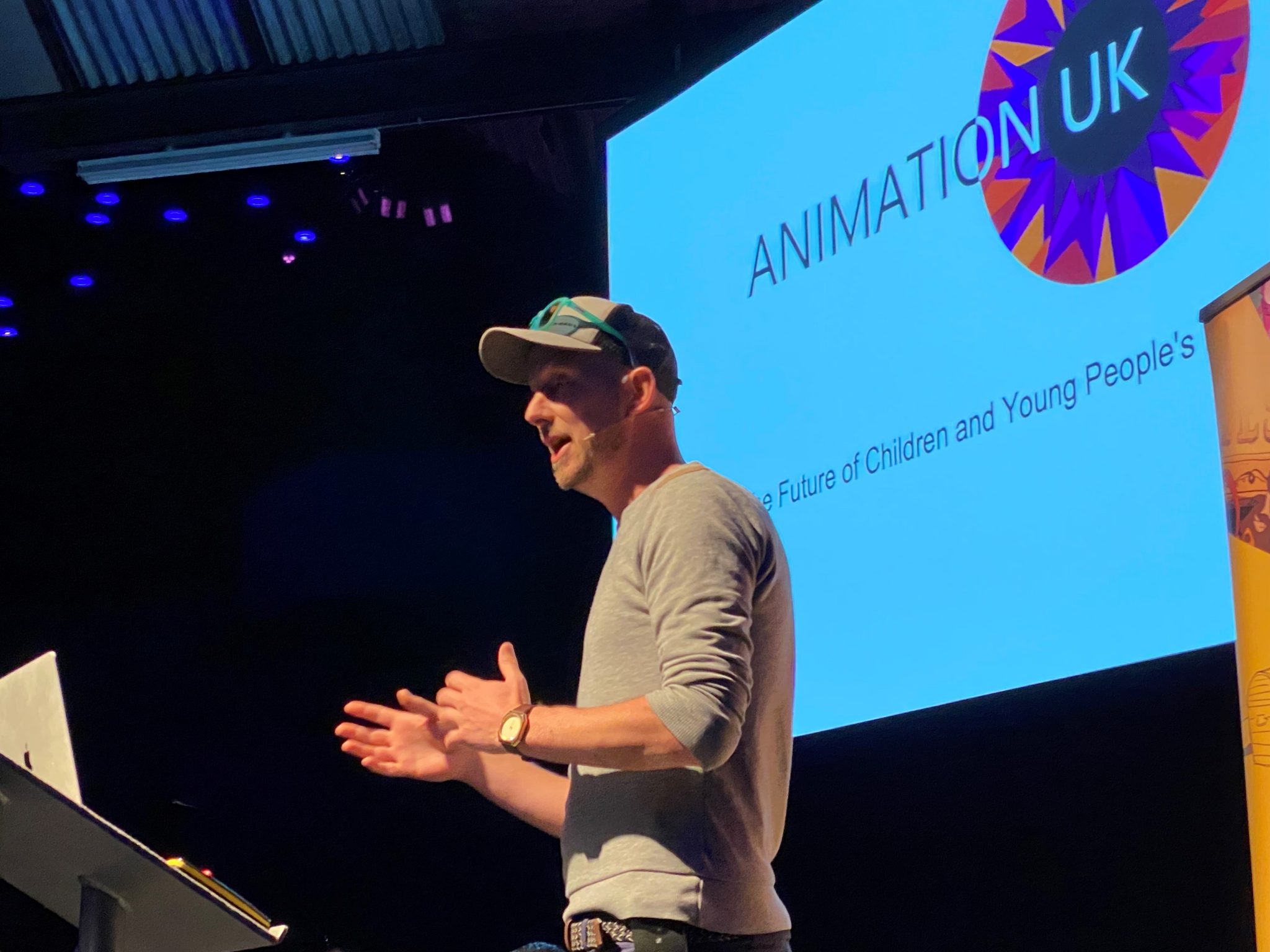
Kate O’Connor, Executive Chair of Animation UK and Mark Taylor, MD of A Productions were panellists in the UK Creativity – Talent-driven and World Beating session – a session highlighting why animation is such an important sector of growth and the UK is attracting such interest from investors and what we need to do to ensure this continues.
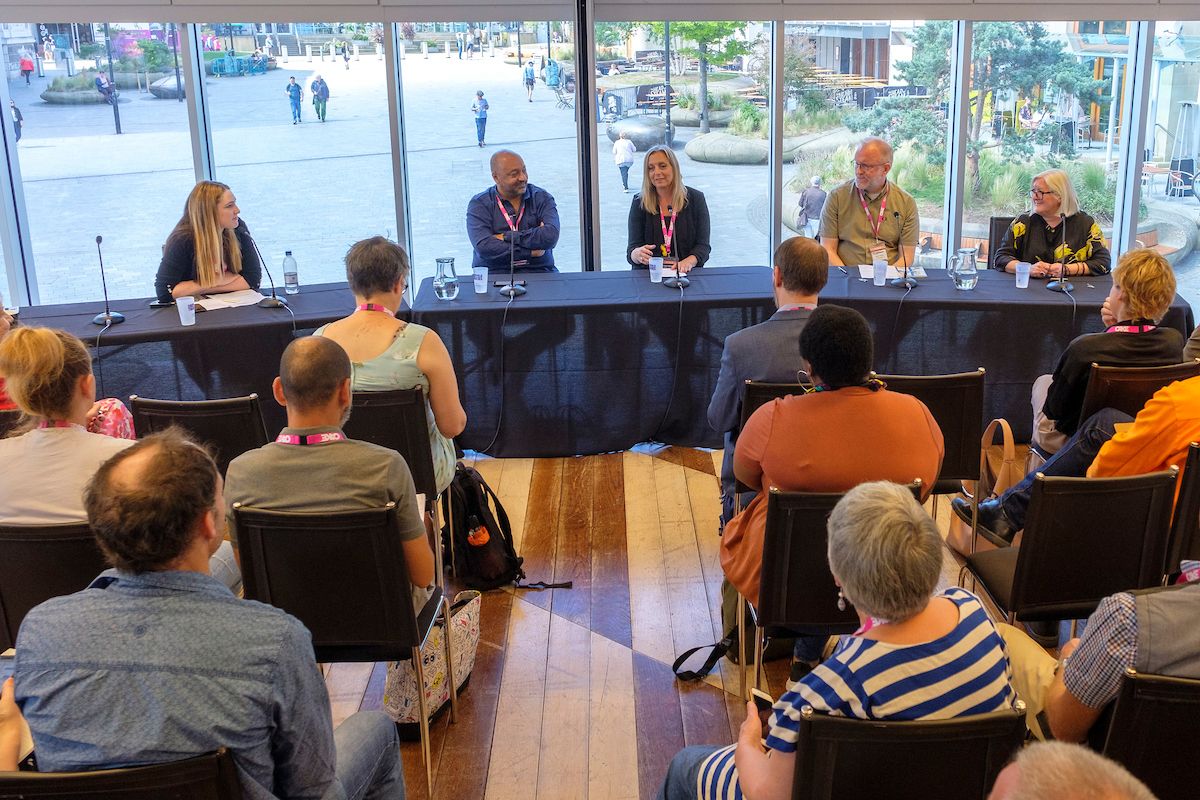
Thursday morning also saw the launch of a new digital pitching opportunity delivered by C21 in partnership with Animation UK and funded by the BFI Global Screen Fund.

Being in Sheffield was also a time to catch up and we were delighted to see so many friends and supporters at our drinks reception which took place at the Showroom Workstation. We would like to give special thanks to Fitzrovia Post, who kindly sponsored the event and who share the passion we have for animation.
We thoroughly enjoyed connecting with people over wine at the Animation UK reception and are keen to discuss anyone’s audio needs and provide a competitive quote for sound design and mix, through to voiceover. We take pride in having a mainly female engineering team and boast an outstanding credit list that crosses all genres and skillsets since establishing nearly 30 years ago.
Keiran Brown, Owner & Director of Fitzrovia Post
Find out more about Fitzrovia Post here and get in touch with Keiran Brown at keiran@fitzroviapost.com
If you are interested in any of the issues raised by the work of Animation UK, please get in touch by contacting kate@ukscreenalliance.co.uk and subscribing to our newsletter here.
Stay in touch with us at Animation UK – lots of exciting events and activities coming up!
Fatal error: Uncaught Error: Call to undefined function twentynineteen_the_posts_navigation() in /home/forge/www.ukscreenalliance.co.uk/public/wp-content/themes/ukscreen/archive.php:41 Stack trace: #0 /home/forge/www.ukscreenalliance.co.uk/public/wp-includes/template-loader.php(106): include() #1 /home/forge/www.ukscreenalliance.co.uk/public/wp-blog-header.php(19): require_once('/home/forge/www...') #2 /home/forge/www.ukscreenalliance.co.uk/public/index.php(17): require('/home/forge/www...') #3 {main} thrown in /home/forge/www.ukscreenalliance.co.uk/public/wp-content/themes/ukscreen/archive.php on line 41
